
The mark of the conservation professional
IHBC East Midlands Branch
Derbyshire, Leicestershire, Lincolnshire, Northamptonshire and Nottinghamshire
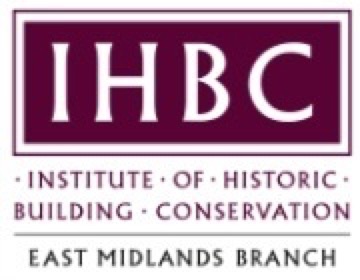
- Branch news
- Bursary
- Events
- Committee contacts
- Archive
- Education Pack
Based on the decisions made at the Branch AGM held in September 2023, our key objectives for 2023 / 2024 are:
- Supporting Members – continued response to member’s needs / requests to help develop the profession
- Increase number of East Midlands members.
- Building Partnerships – through continued representation by branch members on advisory committees, panels and forums.
- Maintaining an Active Branch – through regular Branch meetings, links though County groups and County Reps and CPD events and electronic networking.
- Send 1 full place to the 2024 IHBC Conference
To read the full Business Plan, go to:
Business Plan, 2023-24 (as agreed at AGM and approved at the December IHBC Council meeting)
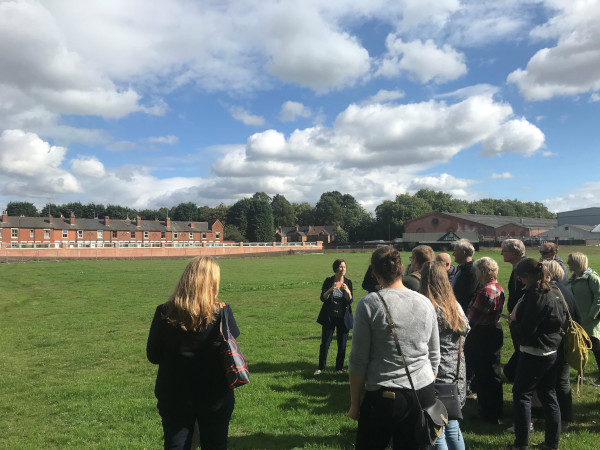
Chloe Oswald explaining at the 2018 AGM CPD event the extent of the flood defences recently installed in Derby
IHBC East Midlands Branch 2025 Annual School Bursary
IHBC Annual School – Shrewsbury 2025
HERITAGE IN CONTEXT
Value: Plan: Change
Full School - 12th to 14th June 2025
Day School - 13th June 2025
The East Midlands Branch is pleased to announce that once again it is able to offer potential bursary options for the IHBC Annual School, which this year will be hosted from Shrewsbury. The event will explore the relationship between ‘context’ and the historic environment – how we value, manage and preserve its significance in the face of continued change and intervention.
Enjoy, engage and learn at IHBC Schools across:
- 1 day conference (Day School, with in-person and online)
- 3 day conference (Full School) including the Day School as well as tours, receptions, Awards and Annual Dinner.
Talks, Tours and more: delegate options for #IHBCShrewsbury2025 in more detail:
- Day School, Delegate, in-person and online options Friday 13th June: A day of presentations, networking, discussion and learning.
- Full School delegate in-person option Annual School, 12-14th June: A multifaceted programme including the above programme. Expert and specialist tours and on-site investigations, across two days, building on the School theme and location. Plus unique networking and celebratory opportunities including the School Reception on the Thursday evening, and the Annual Dinner on the Friday (including IHBC Student Award and Marsh Award presentations.
See the website for more information as it becomes available, you can also sign up for updates on this year’s school.
https://shrewsbury2025.ihbc.org.uk/
1. Our Branch Bursary Eligibility Requirements
The Bursary options are open to all IHBC East Midlands Branch supporter, affiliate, associate and full members.
2. Bursary Information
The East Midlands Branch is providing options for the Branch Bursary Award(s) to cover to cost of the school (please specify which option you are seeking on your application ie full school in person, day school only in person, or, day school online.
Options are as follows:
- 1 award of £360 towards the full school (non-residential) with Annual Dinner excluding travel and subsistence; or,
- 2 x £180 for the day school on Friday 13th June excluding accommodation, travel and subsistence; or,
- 1 x £180 for the day school on Friday 13th June excluding accommodation, travel and subsistence AND 4 x £42 online day school places; or,
- Up to 9 x online day school places.
The successful recipient(s) must confirm they can commit to attendance for the option they are seeking.
It will be a requirement of the successful recipient to also confirm they are willing to:
- Attend at least two branch committee meetings and one in person event per year, and;
- Produce a short article and photographs from an IHBC event to include on our branch webpage.
If you are interested in applying for the Bursary you should submit your application in writing to the Branch’s Chair, Matt Bentley, by email to Matthew_Bentley@n-kesteven.gov.uk by Friday 23 May 2025.
3. Selection Criteria
Your application should set out, in no more than 500 words, your case for receiving the award and what you would be able to contribute in return that would benefit the activities and/or promotion of the IHBC either at Branch or national level (in addition to the eligibility requirements).
A team from the Branch Committee will be responsible for selecting the recipient of the Bursary, based on the merits of the case and according to need. Whilst the Bursary is open to all IHBC East Midlands Branch members, in selecting the successful candidate the Branch Committee will give preference to applicants who are:
- Either unwaged and/or full time student on a conservation course;
- New entrants to the profession (under 5 year’s full time employment in a heritage related role) and whose employer is unable to fund a place on the school; and
- Members wishing to upgrade to their membership this coming year.
NB Please be aware the Branch bursary is independent of the national IHBC Bursary on offer which you could also apply to separately.
Past Winners and Testimonies
2019 Annual School, Nottingham - Heritage, Risk & Resilience confronting conservation calamities
https://www.ihbc.org.uk/nottingham2019/
EM Branch Bursary award winners
- Kerry Walmsley (Assistant Conservation Officer, South Kesteven District Council)
- Vicky Mellor (Archaeologist, Acorn Archaeology, Lincolnshire)
- Tyler Barton (Planner, Leicester City Council)
IHBC Annual Day School 2019 – Testimonial by Tyler Barton
“Primarily, I want to express my gratitude to the IHBC’s East Midlands regional branch for granting a bursary that allowed me to attend the IHBC’s Annual Day School 2019. By way of giving thanks, I hope to highlight the success of the school by detailing my own experience, whilst also trying not to be too bias (of course!) given that my work friend Justin Webber was chair of the school.
Nottingham, the ‘Queen of the Midlands’, was an excellent choice to host the school. Not only does the city have an abundance of built heritage which delegates were able to enjoy throughout the day; it is also a UNESCO City of Literature, the ‘Home of English Sport’ and the homeland of Robin Hood. It also has several pubs that lay claim to be the oldest in England, but more on that later! It was especially enjoyable to visit the city as an enthusiast of Victorian architecture, with Nottingham also being known as a ‘Victorian Lace City’.
Some other delegates, including myself, were already able to see some of the city’s-built heritage during the pre-school event on contemporary challenges and solutions for protecting heritage in the East Midlands. The event was very generously held by the IHBC East Midland’s branch for free and took place just short of a month before the school in Nottingham’s ‘Urban Room’, an exhibition and events space dedicated to improving our built environment. Of particularly topical interest, and tying in with the theme of the annual school, was Dr Cathy Daly’s presentation on climate change and the built heritage.
Travelling by train to the day school, the first piece of the Nottingham’s built heritage to appreciate was the Grade II* listed Nottingham Train Station, built in 1904 for the Midland Railway Company in the Neo-Baroque Style. After departing the station and with some time to spare, the ‘school day’ began in perfect fashion with a coffee from Nottingham’s home-grown coffee shop: ‘200 Degrees’. The shop on Carrington Street is housed in a former Victorian Railway Hotel, aptly located close to the Station, and adjacent to the Nottingham Canal. The seating area gave a picturesque view of the canal and the Carrington Street bridge, a cast-iron flat bridge of the mid to late 19th century.

200 Degrees overlooking the Nottingham Canal and Carrington Street Bridge (Source: Author)
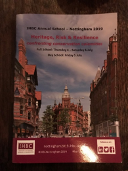
Annual School Programme (Source: Author)

Newton Building, Nottingham Conference Centre (Source: Author)
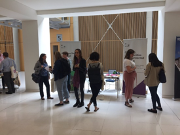
NMott Macdonald’s Exhibition (Source: Author)
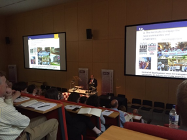
Keynote Speaker (Source: Author)
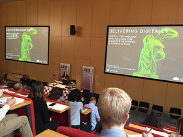
Dr Lyn Wilson's presentation (Source: Author)
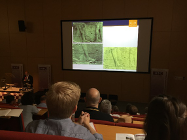
Keynote Speaker (Source: Author)
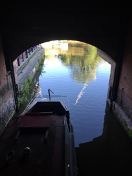
Picture of the canal’s arm taken from a bridge that was inside the pub (Source: Author)
Delegates travelling from the station to the venue were also able to appreciate what is my favourite building in Nottingham, and the building chosen as the cover for the school’s programme, the Prudential Assurance Offices: a grade II red brick and terracotta listed building built 1880-1890 in the Flemish Renaissance Revival Style by Alfred Waterhouse.
The choice of venue for the school was also an excellent one, namely Nottingham’s Conference Centre which is housed in not one but two Grade II* listed buildings: Nottingham Trent University’s Newton Building (1956-1958) and the Arkwright Building (1877-81). Both were in a beautiful architectural setting and made for a visually impressive arrival to the school. The wonderfully clear blue skies of the day also made for some good picture taking, as I hope that you will agree! Delegates walking from the station to the venue would have also appreciated Cecil Hewitt’s most notable work en-route, the Nottingham Council House. Many delegates were also able to explore the interior of the building in the evening, during the school’s annual dinner.
Upon arrival to the school, there was the first opportunity for refreshments and exhibition networking within a bustling atrium. Especial thanks to McParland Finn Ltd for sponsoring the refreshments that catered well even for a fussy lactose-intolerant such as myself!
The exhibitions were comprehensive in their range, from Historic England’s Technical Conservation Department to the Heritage Trust Network. Having only worked for the public sector in my conservation career thus far, it was interesting to discuss all things heritage from different perspectives. The image below shows the Mott MacDonald’s exhibition on their consultancy for heritage on archaeology.
Of particular interest to me was the exhibition on the East Midlands Historic Environment Research Framework, an interactive digital resource. As an unexpected benefit, it sparked an idea in me for possible research during the IHBC accredited Masters in Urban Conservation that I am currently studying for.
Once the first session of refreshments and exhibition networking had finished, it was time for the day school to be launched to a well-attended lecture theatre. The theme for the school was Heritage Risk and Resilience: confronting conservation calamities. By cruel serendipity, the school followed several national news stories of conservation calamities in recent times, including a fire in 2018 to the very same Nottingham Train Station that many delegates arrived to earlier in the day. Another such story was the, again cruel, second fire to the Glasgow School of Art in June 2018. Liz Davidson, the Senior Project Manager for the Glasgow School of Art, detailed in an interesting but sombre fashion the reconstruction of Mackintosh’s masterpiece as well as dealing with the aftermath of the fire - the single biggest threat to heritage. Accordingly, the first session of the day was concerned with fire, including a presentation given by Oxford University’s Fire Officer on working with the fire and emergency services.
The school was divided into four sessions covering fire (Session 1), Structural Failure & Heritage at Risk (Session 2), Security, Digital Technology and Legal Issues (Session 3) and Flooding (Session 4). Within each session there were several expert speakers who each gave 20-minute ‘short-and-snappy’ presentations to keep delegates engaged throughout.
Like the exhibitions, the presentations for the day school were also comprehensive in their coverage. They looked at the potential impact of various conservation calamities, both man-made and natural, on historic buildings and the historic environment. Far from being only about the harm that these conservation calamities cause, the presentations also positively explored the development of practical solutions to help protect buildings and areas from threat, as well as how to deal with the consequences when disasters do strike. Thus, the event provided ample opportunity for continuing professional development and gave me an abundance of vital information for when I hope to one day become a conservation officer. Perhaps most relevant to this future goal was the very informative presentation delivered by Nigel Hewitson, who was legal director at English Heritage for several years, which focused on the legal powers of saving heritage assets in disrepair.
Hewitson’s presentation was followed by his co-author, Dr Charles Mynors, who presented in an enthusiastic and charismatic manner on the legal consequences of the destruction of heritage assets. Mynors is a lawyer for the Law Commission of England & Wales, showing the high calibre and quality of the speakers in attendance.
As already alluded to, I have an interest in the use of the digital for conservation. As such, my interest peaked with Dr Lyn Wilson’s presentation on digital technology for future proofing against disaster. Dr Wilson is the Digital Documentation Manager for Historic Environment Scotland (HES) and her presentation covered many interesting points, including 3D digitisation of heritage assets. Perhaps most interesting of the presentation was the ‘Scottish Ten’, a five year project that aims to use technology to create accurate digital models of Scotland’s five world heritage sites (WHS) in addition to five other WHS elsewhere in the world, in order to better conserve and manage them.
Whilst it is not possible for me to detail all of the presentations that were held throughout the ‘school day’, it would be wrongful of me not to mention the presentation given by the keynote speaker Dr Zaki Aslan, a conservation architect and Director of the ICCROM’s Regional Conservation Centre in Sharjah. Having almost exclusively focused on English conservation throughout my education and career thus far, it was interesting to learn about international approaches to recovery and disaster management of historic environments.
It was pleasing to note that whilst the event was held in the East Midlands, the presentations were comprehensive in their geographic coverage, ranging from the international level right down to the local level. Much to my work friend’s surprise, a photo of her family’s bookshop in the historic town of Cockermouth (Cumbria) was included in Helen Brownlie’s presentation on the recovery and improvement of the historic town after it experienced flooding.
The school also included ‘spotlights’ with the last one shining on Brighton’s IHBC Annual School 2020. The success of the 2019 school has set the bar very high and will be a tough act to follow, but I am sure that the IHBC’s South East branch will be up to the challenge.
But the day didn’t end there. Very dutifully, a pub list was published for the annual school which was given to delegates on arrival. It may be claimed that the pub list is a conservationist’s essential for Nottingham, given that the city hosts several pubs which claim to be the oldest in England. Up for debate are the Ye Old Trip to Jerusalem, Salutation Inn and The Bell Inn public houses, which are all housed in Grade II listed buildings. It was only right and appropriate then that the day school should be unofficially finished with a trip to one of Nottingham’s many historic pubs!
We ventured to The Canalhouse, which the pub list informed us is a grade II listed building consisting of a characterful conversion of a former warehouse built in 1895. An arm of the canal runs into the building with narrowboats moored inside.
The pub also gave me an opportunity to network further as I was able to have a detailed conversation with a former PHD student at The University of Leicester’s Centre for Urban History. With the hope and intention of studying for a PHD in Urban Conservation one day, the advice that she gave me was invaluable and the cherry of top to an enjoyable day of learning about all things heritage – thanks again to the IHBC East Midland’s branch. “
2018 Annual School, Belfast – Our Shared Heritage
No award.
2017 Annual School, Manchester – Transport Infrastructure: the backbone of civilisation
EM Branch Bursary award winner – Emilie Wales (Conservation Officer, ENGIE)
“I came across the 2017 bursary when writing my membership upgrade application from Affiliate to Associate, my sponsor suggested I apply. It was sold to me that the additional CPD at the annual school would help towards my eventual full application, so I applied – and was successful! The event was held in Manchester, the venues and talks where both interesting and informative. However, it wasn’t just the CPD that was of benefit, as a lone conservation officer it’s not often I get to meet with other conservation folk so it was also a great opportunity to socialise. It was also humbling to see that the problems I face in North East Lincolnshire are the same everywhere. For my sins I also volunteered to take a position on the Branch Committee… I have been secretary ever since... Branch also gives me the chance to meet new people and network. The support received throughout my early career has been invaluable.”
2016 Annual School, Worcester – People Power: The Catalyst for Change!
EM Branch Bursary award winner – Liz Mayle (Principal Historic Buildings Consultant, Liz Mayle Heritage Consultants)
2015 Annual School, Norwich – Cultural Connections: Conserving the Diversity of Place
EM Branch Bursary award winner – Rose Thompson (Assistant Inspector of Historic Buildings and Areas, Historic England)
2014 Annual School, Edinburgh – The Art of Conservation
EM Branch Bursary award winner – Simon Revill (Architect, Simon Revill Architecture)
“The Edinburgh School was most beneficial, particularly the conservation workshops and preservation of sculptural work, while the lectures during the day school were thought-provoking as well as discussions with other delegates after the formal lectures. Overall my Annual School visit has improved my conservation skills and knowledge and it was particularly useful to see how others dealt with similar conservation issues.”
2013 Annual School, Carlisle – Skills
EM Branch Bursary award winner – Liz Blood (Heritage Support & War Memorials Officer, Leicestershire County Council)
“Receiving the 2013 bursary was a great surprise. Without it I would have been unable to attend even the day school. The opportunity to take part in the Carlisle 2013 (my first full school) was a fantastic introduction to how valuable the tours and visits are on the extra days. These helped to put the day school theme of Skills into context, and to see real case study projects on the ground. It also provided opportunities to find out what interesting and inspiring projects others are involved in. It was a privilege to attend, I am most grateful to the EM branch for offering the bursary, and hope that the photojournal-film I produced as a momento will urge you to consider applying for the next – do not miss out!
Bursary Feedback - IHBC 2013 Summer School Carlisle
2012 Annual School, Winchester – Significance: Who Decides?
EM Branch Bursary award winner – Lisa Walton (Conservation Officer, NE Derbyshire District Council)
“In 2010 I was successful in securing a post which allowed me to work as a Planning Officer whilst training to be a Conservation Officer. I enrolled on an IHBC accredited course and became an affiliate IHBC Member. This has been the start of an incredible journey for me. I was encouraged by my local IHBC Branch representative to apply for the IHBC Annual School bursary as a way of building up knowledge and understanding in the field of conservation and gaining some bespoke CPD experience. After finding out I had been awarded the bursary, the East Midlands Branch ensured my full day school place was booked. All I had to do was arrange my travel, the cost of which was also covered by the bursary. Without the assistance of my IHBC Branch I would not have been able to attend and what an experience I would have missed out on! From the fantastic site visits to the expert speakers who spoke on a wide variety of topics to the delegates who were amazingly friendly and interested in the background of others. The whole experience was a seamless series of well-organised events and activities, highlighted by the beautiful city of Winchester. Without a doubt I have benefited from the experience and feel I can now offer my employer and my branch a wider appreciation of the historic environment and understanding of its ‘significance’. It is still daunting for me to think about how much I still have to learn but I am grateful for the opportunity the East Midlands Branch has provided, through its bursary scheme, and it is their belief in me that makes it such a greatly appreciated award. I would encourage anyone starting out in the field to apply for the bursary.”
Following the Annual School, Lisa has reported back the experience of attending the School to her County colleagues and has prepared the following presentation to share her CPD with other members.
Bursary Feedback - IHBC 2012 Summer School Winchester
2011 Annual School, Llandudno – Navigating the Shallows: Conservation and stewardship in uncertain times
EM Branch Bursary award winner – Catherine Dove (Conservation Officer, Leicestershire County Council)
"I have been an affiliate member of the IHBC for three years and am working towards full membership. I always find the Annual Schools that the Institute runs really useful; previously, I've only been able to afford the day schools, as I have to self-fund the trip. Last year, I applied for the East Midlands bursary as I didn't think I could afford to go, and was delighted to gain the bursary! The full trip is really worth the experience, as you get to go on useful site visits to see how innovative and fascinating projects are put into practice (among other sites, I visited Conwy castle and town walls and a school that had been converted by a local trust for community use) as well as a themed day of interesting lectures, with plenty of time for discussion and networking. The Annual Dinner is also a great experience. I would really encourage you to apply for the bursary, even if you don't think you'll be successful- you may be pleasantly surprised!"
Following the Annual School, Catherine fed back her experiences to the EM Branch Committee and also gave a presentation to the Branch on her work at Leicestershire County Council. This gave Catherine the opportunity to meet the Branch Committee and to contribute to the discussions on Branch publicity and hear about current conservation issues in the other counties.
2010 Annual School, London – Going for Gold
EM Branch Bursary award joint winner – Lynda Tomkins (student, IHBC accredited architectural conservation degree, University of Derby)
“The bursary is a great idea. We all need a little help as we enter a new career.”
EM Branch Bursary award joint winner – Liz Bates (Historic Buildings Manager, Heritage Trust for Lincolnshire)
“Overall, the Day School showed how historic building conservation can both inform change and adapt to it. The case studies illustrated the value of the range of professionals working within the sector.”
Following the Annual School, both Lynda and Liz have reported back their experiences of attending the Day School within the September 2010 edition of Context.
Forthcoming Branch Meetings
- Wednesday 10th December 2025 (7pm online)
- Wednesday 4th February 2026 (7pm online)
- April meeting venue and date tbc
- Wednesday 1st July 2026 (7pm online)
- September/October AGM venue and date tbc
Recent Events
IHBC East Midlands AGM and CPD Event
Heritage and Placemaking
6th October 2025 9:30 – 16:30
£35 – £40
Newark Civil War Museum
14 Appleton Gate, Newark NG24 1JY
Join IHBC East Midlands for our combined AGM and CPD event covering heritage and placemaking.
The event will be held within the Tudor Hall at the restored Newark Civil War Centre and Museum, a grade II* listed building.
Our speaker for the day will be Dave Chetwyn whose extensive experience includes complex mediation between public bodies, planning negotiations, planning for heritage, heritage-led regeneration, neighbourhood planning, statutory consultation (legal compliance) and third sector organisational development.
Lunch and refreshments will be provided within the ticket price for the event which is £35 for IHBC members (all levels) and £40 for non-IHBC members. Dietary requirements will be sought post ticket purchase.
Newark is readily accessible by train and car with several nearby car parks to the venue.
A timed itinerary for the day will be circulated closer to the event.
IHBC Area of competence – philosophy and theory, practice, design and presentations, historic and architectural interest, legislation and policy and economics.
IHBC East Midlands AGM and CPD Event
Fire Safety in Traditional and Historic Buildings
28 April - 08:00 - 17:00
£35 – £40
Newark Civil War Museum
14 Appleton Gate, Newark NG24 1JY
Join IHBC East Midlands for our first CPD event of 2025 covering fire safety in historic and traditional buildings.
The event will be held within the Tudor Hall at the restored Newark Civil War Centre and Museum, a grade II* listed building.
Our speaker for the day will be Steve Emery, with 50 years experience in fire safety, initially in operational firefighting, the last 35 of which are with historic or traditional buildings, Steve has worked for English Heritage, Historic England, City of Bath and Oxford University as well as working with both the Landmark Trust and National Trust.
The subjects for the day will include:
- An overview of fires in historic/traditional buildings.
- Legislation and guidance.
- Cathedrals, churches, roofs and firefighting.
- Fire Doors.
- Q&A
Lunch and refreshments will be provided within the ticket price for the event which is £35 for IHBC members (all levels) and £40 for non-IHBC members. Dietary requirements will be sought post ticket purchase.
Newark is readily accessible by train and car with several nearby car parks to the venue.
A timed itinerary for the day will be circulated closer to the event.
IHBC Area of competence – All
IHBC East Midlands Branch CPD Event
Leicester City HAZ
Tuesday, November 12 2024 - 10am - 4:30pm
Join the IHBC East Midlands Branch for a CPD event exploring city and town centre-based heritage led regeneration. Hear from lead officer’s on the successes, problems and journey of these projects which include two High Street Heritage Action Zones and a Townscape Heritage Initiative.
The event will comprise of talks and a tour of the nearby Heritage Action Zone area, lunch and refreshments included within the ticket price, with a limited number of free student places available (note these places do not include lunch/refreshments).
Monday 27th March 2023
Hardwick Hall, Doe Lea, Derbyshire
More often than not, my drives around M1 Junction 29 have been in poor weather and ‘Hardwick Hall more window than wall’ has been shrouded in mist. However, the sun shone for our Branch #IHBC25 event and the sunlit, sparkling windows of ‘new’ Hardwick Hall met us on our approach.
Hardwick Halls, both old and new, along with Bolsover Castle and Sutton Scarsdale occupy prominent hilltop locations within the Doe Lea valley which can be regarded as something as a ‘millionaires row’. The visual prominence of great houses, both in the landscape and in competition one with another, eloquently demonstrates the social and political concerns and aspirations of their owners.
The eminent architectural historian Mark Girouard speaks passionately about the Doe Lea valley and its relationship to Hardwick and the other great houses ‘a magic valley out of which rise, each on their own hilltop, enchanted castles or palaces.’….’From Bolsover one can look across the valley to Sutton Scarsdale, or along it to the distant towers of Hardwick. From Sutton Scarsdale one can survey the whole length of Bolsover…’ (Girouard 1983, page 206-7).
After seeing old friends and meeting new over refreshments, Roy Lewis began the #IHBC25 event in the kitchen, where all the best parties happen of course! Roy has been a key player within the IHBC and East Midlands branch from its earliest days and provided an insightful potted history of 25 years of the IHBC and our Branch role within that.
We moved upstairs for our morning presentations which began with Dr Karey Draper (Caroe Architecture) for an outline of the history of the Hall and some of the work that has been undertaken to produce the Conservation Management Plan.
Dr Adam Menuge (University of Cambridge) followed on looking at specific elements of the Hall and its significance. With its commanding position at the top of the west facing scarp, Hardwick Hall was designed to ‘see and be seen’. It was highlighted that the size of the windows reflect the hierarchy of the rooms, with the largest windows serving the state rooms on the second floor, and the High Great Chamber, Green Velvet Room and Blue Room all commanding framed views out over the Doe Lea Valley.
It was pointed out that despite the amount of windows, some rooms have always relied on borrowed light. In part due to a mezzanine floor at second floor level although this is not apparent when viewed externally.
We were given an insight into stair precedents and norms which are evident at the Hall. Long straight processional stairs are in place along in addition to newel stairs leading off a central staircase.
A short tour ensued looking at elements that had been covered in the morning presentations. We saw that C17 stairs became an interesting feature themselves as they moved from being enclosed stairs, to open stairs with views across landings. We also saw delightful late C16 projecting noses on steps at higher levels. Battlements are also a feature on staircases at the Hall, in stone and timber.
After a conversation and food filled lunch break back in the kitchen, we headed back upstairs. Oliver Jessop (The Jessop Consultancy) was waiting for us and took us to dizzy heights with a presentation on the roof structures at the Hall. An accurate phasing plan was achieved through the use of Photogrammetry, an ideal technique when there is limited or no person access since a cherry picker can be used to take images from above.
The different phases and repairs at the Hall have shown a wide range of construction techniques. Dating has also been aided through the identification of different nail types and carpentry marks. Design changes as the Hall project progressed have also been highlighted through the survey.
Mark Balkham (Rodney Melville & Partners) set out some key stages within the Hall’s 10 Year Plan. The ethos behind the plan is to ensure that visitors do not realise works have taken place. Now in year 7 of the plan, the exterior works are complete and interior works will start to take place next. The Conservation Management Plan has been invaluable in informing the process.
A final short tour of the exterior followed where we were able to see some of the stone repair works which generated a conversation about sourcing stone to ensure the best fit with projects and local distinctiveness. We also had opportunity to observe areas of the Hall with unfulfilled design details such as a potential balcony which has been put forward as an idea due to door sized blocked up areas in windows.
We would not have been able to convene this event without the generous support of The National Trust, the ‘in kind’ time of our speakers, and the #IHBC25 grant from the central budget, and we wish to express a sincere thank you for everyone who played a part in the day.
Kim Miller (Branch Committee member) was instrumental in helping arrange the day while she worked at NT, and we wish her all the best in her new role and move to the South West. Your Branch support has been much appreciated while you’ve been with us Kim!
A last point to note is that rather than having a peripatetic April event where we incorporate a Branch meeting with CPD learning we ran the event as a full day learning feature as part of #IHBC25 celebrations. We asked for feedback from delegates and the information received indicated that the full day learning event was preferred so we will look to repeat this event format and keep branch meetings online. For all meetings and events you are welcome to join irrespective of your level of IHBC membership. We are looking to hold a MATES event and will let you know as soon as that is arranged.
Rosamund Worrall, Branch Vice Chair
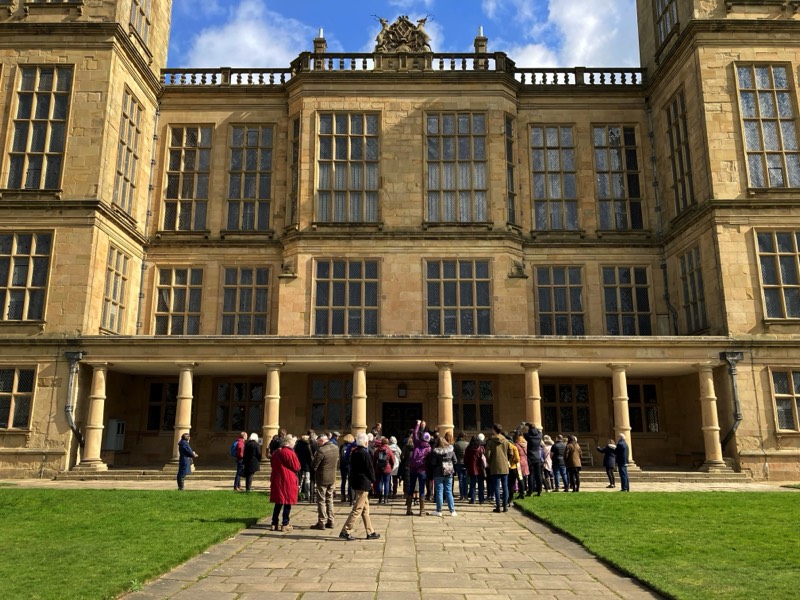
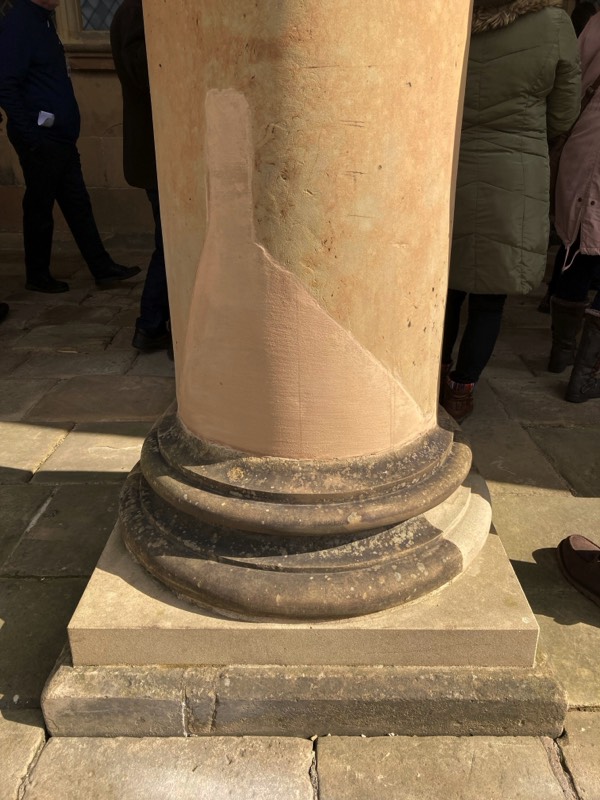
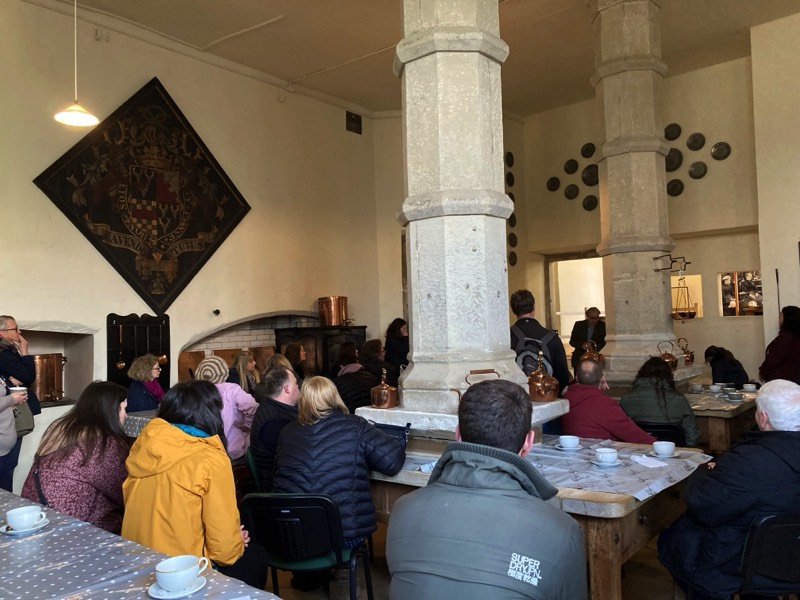
IHBC East Midlands Virtual Membership Application Training Event (MATE), Wednesday 13th October 2021.
Bolsover Model Village
The afternoon CPD event followed our AGM and began with an excellent overview of the New Bolsover Model Village project presented by Kim Wyatt and her colleagues. It was really good to see both the District Council’s Building Surveyor and the project Architect there to answer questions about the project. We had a brief but highly enjoyable visit to Bolsover Castle on a bright sunny day with a smashing view over New Bolsover Model Village, which was a lovely start to our afternoon tour.
Research regarding energy efficiency appropriate to historic buildings, transposing the findings to well over 180 houses, the reinstatement of excellent joinery which has restored integrity and unity to the model village, incorporating double glazing and vastly improved yet appropriate thermal efficiency, increasing property values despite decreasing the number of bedrooms, and working with residents and local community to transform the Model Village. This project demonstrated how to bring together the best of the old balanced with the very discreet new to make comfortable, energy efficient homes fit for the future. Thanks from all those who attended to Kim Wyatt and Chris McKinney for arranging the event.
Liz Mayle, photos Fiona Newton, Vicky Mellor
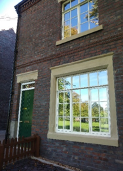
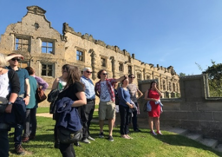

April 2019
Collyweston Slate Heritage Centre
Messenger construction were marvellous hosts for our April 2019 peripatetic meeting held at their brand new Collyweston Slate Heritage centre. Collyweston is a distinctive local material of the East Midlands that takes its name from the village of Collyweston and has been used as a building material since the Roman period. The day began with a potted history of how the slate has been mined, the frosting method which has been developed by messenger in partnership with Historic England and a virtual tour of the mine which is on site. Messenger’s historic paint specialist, Karen Morrisey gave an illuminating talk on historic paint layers, and how the philosophy of conservation underpins her work with examples from Cardiff Castle to Ordsall Hall. The day was topped off by a practical stone slating demonstration showing the unique ways that the slates are fixed and laid in diminishing courses and a showcase presentation of Messengers Collyweston projects on some of the nation’s finest historic buildings. Special thanks go to branch member Matt Webster and his colleagues at Messenger for a superb day. See www.messengerconstruction.co.uk for more information, Kerry Walmsley.
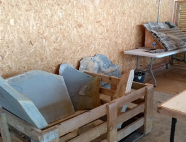
September 2013
Visit to the Lincoln Heritage Centre, Lincolnshire
Following the Branch 2013 AGM, the Branch members were addressed by three speakers about the development of the Heritage Skills Centre.
Mary Powell of Lincoln Castle Revealed described how, having carried out several smaller projects in the Uphill Area, the Historic Lincoln Project focussed on the issues surrounding the Castle. The Castle had been identified as an underperforming attraction that was not generally accessible and in a poor state of repair. It was also recognised that the Cathedral had a highly skilled workforce but these were not generally seen by the public, they therefore wanted the public to see the Cathedral’s craftsman either at work or in training.
So with funding from the Heritage Lottery Fund and European funds the project was able to undertake a combination of repair and new build projects at the Castle.
The site for the Heritage Skills Centre was easily identified, having been previously been used for car parking and general storage. This was also combined with the refurbishment of the Victorian Prison and the creation of a new display area for the Magna Carta, along with repairs to the curtain wall. Although the continuation of the High Court within the Castle grounds created several logistical problems, particularly in terms of noise and disturbance and general access issues.
Rob Green of the architects Arrol and Snell, appointed to undertake the works, described in more detail the nature of the works and the objectives to create a complete circuit of the walls, using newly constructed links and bridges, along with the provision of disabled ac
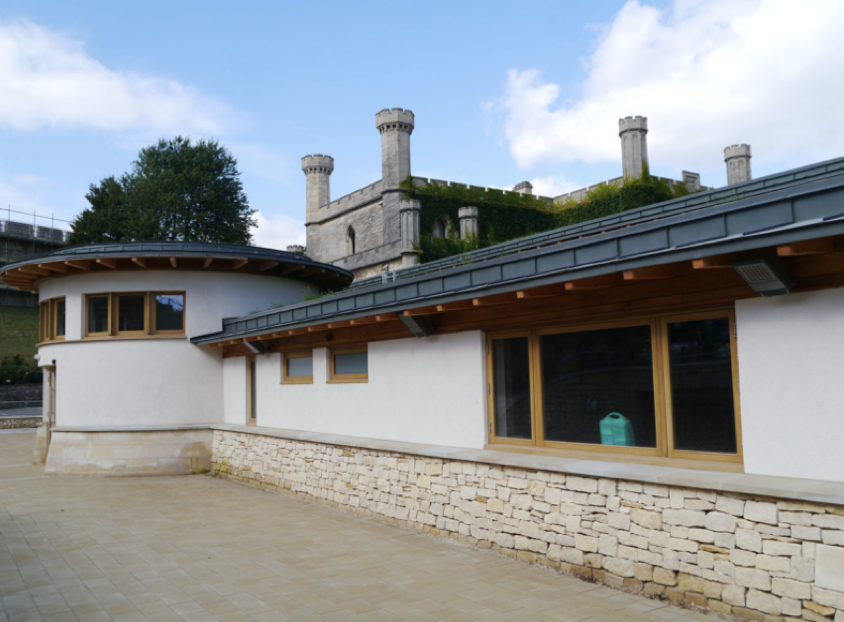

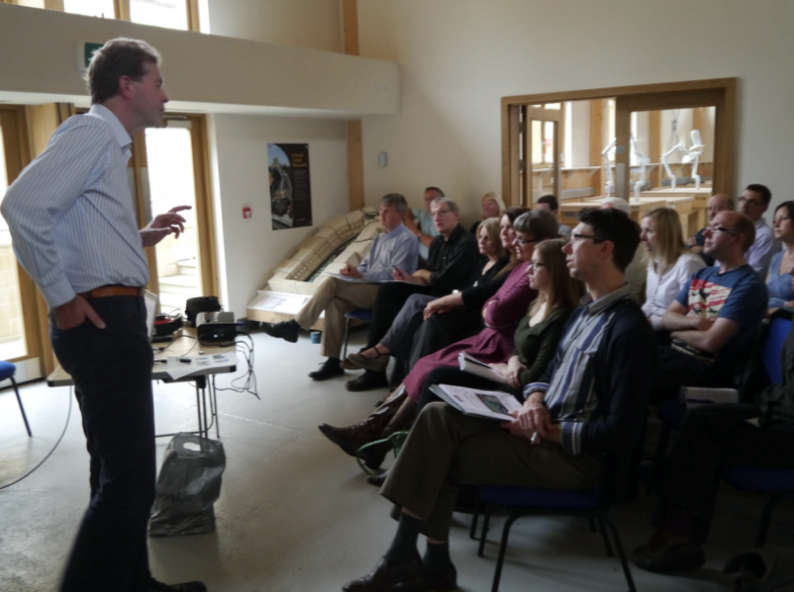
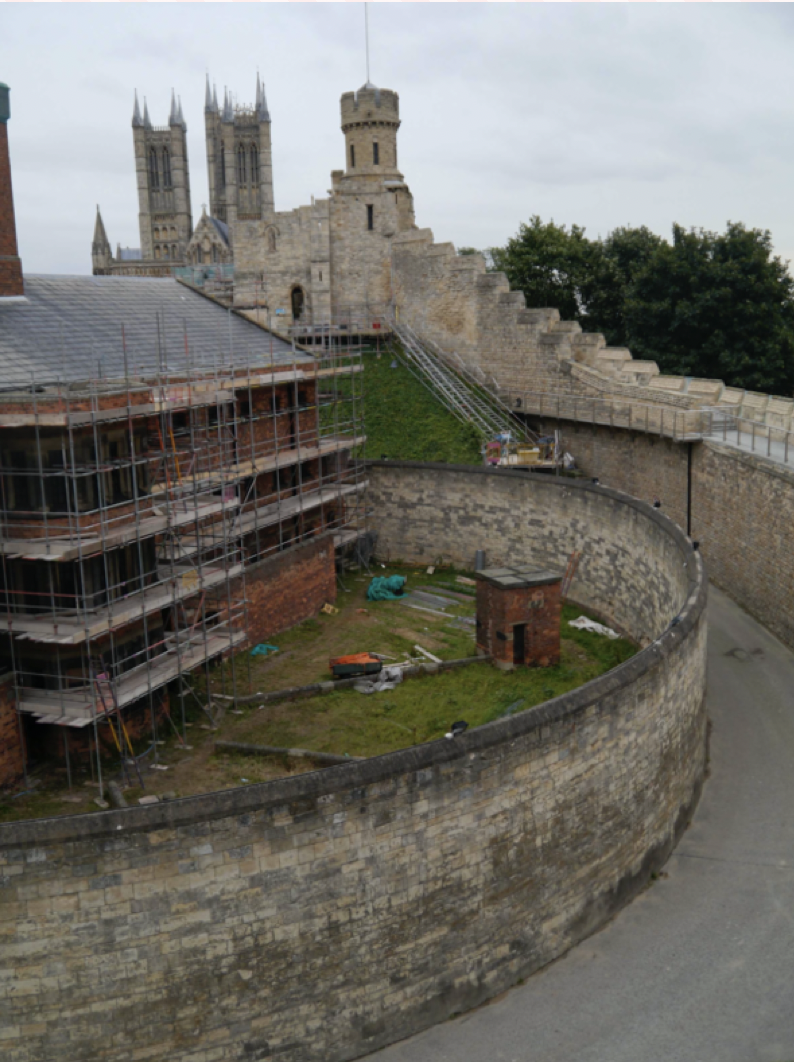
Finally Dr Jonathan Clark of the archaeologists FAS Heritage gave an entertaining presentation describing the extent of the archaeological works within the Castle grounds and the survey work to ‘reconstruct’ the Lucy Tower.
Jonathan also described the uncovering of an interesting sanitation system beneath the site of the Heritage Skills Centre with its 19th Century toilet remains.
The archaeologists also uncovered evidence of a substantial pre-Conquest building under the North lawn, an area that had been thought to be undeveloped and the excavations for the Magna Carta Building revealed layers of buildings showing various periods of occupations beginning with the relatively recent Victorian and Georgian periods, going back through the through the Medieval period with evidence of a Norman hall and an Anglo-Saxon church and ending with a Roman town house.
The archaeologists were also able to uncover various graves cut into the floor of the Anglo-Saxon church including an undisturbed sarcophagus.
After these introductory talks there was the opportunity to climb the steep stairs to the Lucy Tower and to walk along sections of the newly created wall walk, viewing the owl boxes cut into the curtain wall and viewing areas of stone repairs.
Stephen Bradwell
Past events
For more information about past events click on the ‘AGM and general archive tab’ above.
If you are interested in a position on the committee, please contact ihbceastmidlands@gmail.com for further information.
The Committee for 2024-25 is as follows:
You do not have to be named here as a Committee Member to attend. All East Midlands members are welcome. For any members who would like to attend please contact ihbceastmidlands@gmail.com to arrange for the appropriate virtual invitation.
2025
Branch Newsletter July 2025
2024
Branch Bulletin December 2024
2023
Branch Bulletin June 2023
Branch Bulletin December 2023
2021-22
Branch Bulletin July 2022
Branch Bulletin, March 2022
Branch Committee Meeting 20th October 2021
Branch Bulletin, Dec 21
2020-21
Branch Bulletin, August 2021
Branch Committee Meeting 6th July 2021
Branch Committee Meeting 29th April 2021
Branch Bulletin, March 2021
Branch Committee Meeting 2nd February 2021
Branch Committee Minutes, 1st December 2020
Branch Bulletin, Nov 2020
Branch Committee Minutes, 27th October 2020
Branch Committee Minutes, 7th July 2020
Branch Committee Minutes, 12th May 2020
Branch Business Plan 2020-21
2019-20
AGM papers, 20th September 2019 at Bolsover Assembly Hall
Branch Committee Minutes 2nd February 2020
Branch Business Plan 2019-20
2018-19
Branch Committee Minutes, 9th July 2019
Branch Committee Minutes, 5th April 2019
Branch Committee Minutes, 5th February 2019
Branch Committee Minutes, 4th December 2018
Branch Committee Minutes, 30th October 2018
AGM papers, 7th September 2018 at Derby Museum and Art Gallery
Branch Business Plan 2018-19
2017-18
Branch Committee Minutes, 10th July 2018
Branch Committee Minutes, 20th April 2018
Branch Committee Minutes, 13th February 2018
Branch Committee Minutes, 5th December 2017
Branch Committee Minutes, 31st October 2017
AGM papers, 15th September 2017 at The Cosy Club, Stamford
Branch Business Plan 2017-18
2016-17
Branch Committee Minutes, 18th July 2017
Branch Committee Minutes, 11th May 2017
Branch Committee Minutes, 6th February 2017
Branch Committee Minutes, 6th December 2016
Branch Committee Minutes, 25th October 2016
AGM papers, 9th September 2015 at Philip Gaches’ Workshop, Deeping St James
Branch Business Plan 2016-17
2015-16
Branch Committee Minutes, 12th July 2016
Branch Committee Minutes, 28th April 2016
Branch Bulletin, February 2016
Branch Committee Minutes, 2nd February 2016
Branch Committee Minutes, 2nd December 2015
Branch Committee Minutes, 27th October 2015
AGM minutes
AGM papers, 4th September 2015at The Old Hall Hotel, Buxton
Branch Business Plan 2015-16
2014-15
Branch Bulletin, August 2015
Branch Committee Minutes, 14th July 2015
Branch Committee Minutes, 16th April 2015
Branch Bulletin, March 2015
Branch Committee Minutes, 3rd February 2015
Branch Committee Minutes, 2nd December 2014
Branch Bulletin, November 2014
Branch Committee Minutes, 28th October 2014
AGM minutes
AGM papers, 11th September 2014at Hallmark Hotel, Derby
Branch Business Plan 2014-15
2013-14
Branch Committee Minutes, 15th July 2014
Branch Committee Minutes, 25th April 2014
Branch Committee Minutes, 4th February 2014
Branch Committee Minutes, 10th December 2013
Branch Committee Minutes, 29th October 2013
AGM minutes
AGM papers, 13th September 2013 at Lincoln Castle
Branch Business Plan 2013-14
2012-13
Branch Committee Minutes, 16th July 2013
Branch Committee Minutes, 26th April 2013
Branch Committee Minutes, 5th February 2013
Branch Committee Minutes, 4th December 2012
Branch Committee Minutes, 30th October 2012
Training Event, 7th September 2012 at British Geological Survey
AGM minutes
AGM papers, 7th September 2012 at British Geological Survey
Branch Business Plan 2012-13
2011-12
Branch Committee Minutes, 10th July 2012
Branch Committee Minutes, 29th May 2012
Training Event, 13th April 2012 at Stanford Hall
Branch Committee Minutes, 13th April 2012
Branch Committee Minutes, 7th February 2012
Training Event, 2nd September 2011 at Creswell Crags Visitor Centre
AGM papers, 2nd September 2011 at Creswell Crags Visitor Centre
Branch Business Plan 2011-12
2010-11
Branch Committee Minutes, 22nd February 2011
Branch Committee Minutes, 11th January 2011
Branch Committee Minutes, 2nd November 2010
AGM papers, 3rd September 2010 at Cusworth Hall, near Doncaster
Branch Business Plan 2010-11
Branch Committee Minutes, 6th July 2010
Training Event, 24th June 2010 at Hathern Terracotta, near Loughborough
Branch Committee Minutes, 18th May 2010
Branch Committee Minutes, 13th April 2010
Branch Committee Minutes, 23rd February 2010
Branch Committee Minutes, 12th January 2010
Branch Committee Minutes, 3rd November 2009
Business Plan, 2009-10
AGM papers, 4th September 2009 at Harlaxton Manor, near Grantham
2008-09
Branch Committee Minutes, 7th July 2009
IHBC Annual School, 11th-13th June 2009, Buxton
Branch Committee Minutes, 19th May 2009
Branch Committee Minutes, 7th April 2009
Branch Committee Minutes, 24th February 2009
Branch Committee Minutes, 13th January 2009
Branch Committee Minutes, 4th November 2008
Business Plan, 2008-09
AGM papers, 5th September 2008 at Stoke Rochford Hall, near Grantham
Training Event, 24th April 2008 at Taylor’s of Loughborough, Bell Founders
Older AGM papers
AGM papers, 14th September 2007 at The Cathedral Centre, Lincoln Cathedral
AGM papers, 6th September 2006 at Bolsover Castle, Bolsover
AGM papers, 15th September 2005 at New Walk Centre, Leicester
AGM papers, 8th September 2004 at Cromford Mill, Derbyshire
AGM papers, 12th September 2003 at University of Derby, Derby
AGM papers, 17th September 2002 at The Workhouse, Southwell
AGM papers, 23 October 2001 at The Sessions House, Northampton
AGM papers, 26th September 2000 at The Gilstrap Centre, Newark
AGM papers, 3rd July 1999 at Elvaston Castle, Derbyshire
AGM papers, 5th June 1998 at The Inland Revenue, Nottingham
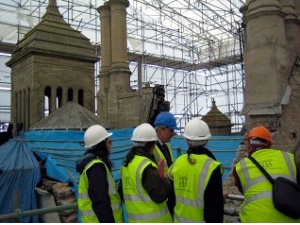
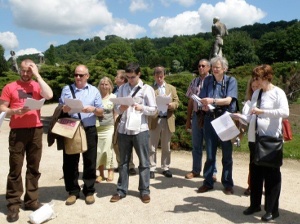

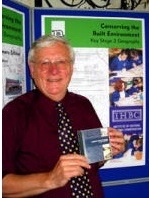
The Conservation and Heritage Education Pack, CONSERVING THE BUILT ENVIRONMENT - KEY STAGE 2 GEOGRAPHY, jointly sponsored by the Institute of Historic Building Conservation and Nottinghamshire County Council, (as referred to in the press release below) was launched on 14th June 2004 by David Lovie the President of the Institute.
It can be downloaded by clicking on this link. (This is a 19Mb download of a PDF file and is therefore unsuitable for slow internet connections) Requires Adobe Acrobat reader which is a free download from www.adobe.com
